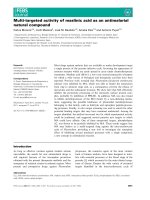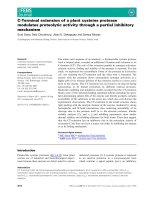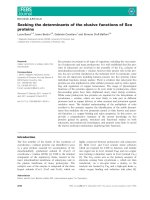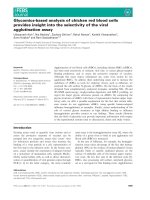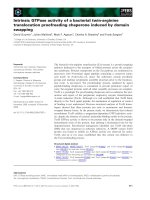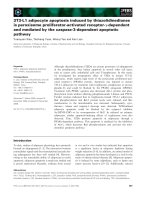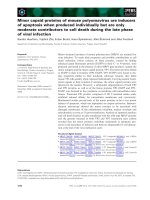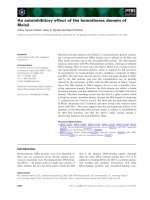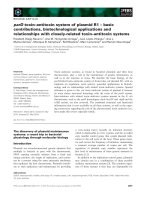Tài liệu Báo cáo khoa học: Two novel variants of human medium chain acyl-CoA dehydrogenase (MCAD) K364R, a folding mutation, and R256T, a catalytic-site mutation resulting in a well-folded but totally inactive protein pptx
Bạn đang xem bản rút gọn của tài liệu. Xem và tải ngay bản đầy đủ của tài liệu tại đây (317.7 KB, 9 trang )
Two novel variants of human medium chain acyl-CoA
dehydrogenase (MCAD)
K364R, a folding mutation, and R256T, a catalytic-site mutation
resulting in a well-folded but totally inactive protein
Linda P. O’Reilly
1,
*, Brage S. Andresen
2
and Paul C. Engel
1
1 Department of Biochemistry and Conway Institute of Biomolecular and Biomedical Research, University College Dublin, Belfield, Dublin,
Ireland
2 Research Unit for Molecular Medicine, University Hospital, Skejby Sygehus, Aarhus, and Institute of Human Genetics, Aarhus University,
Denmark
Keywords
active site; enzyme deficiency; medium
chain acyl-CoA dehydrogenase (MCAD);
point mutations; protein folding
Correspondence
P. C. Engel, Department of Biochemistry,
Conway Institute, University College Dublin,
Belfield, Dublin 4, Ireland
Fax: +353 12837211
Tel: +353 17166764
E-mail:
Website: />Enzymes
Medium chain acyl-CoA dehydrogenase
(MCAD; EC 1.3.99.3); long chain acyl-CoA
dehydrogenase (LCAD; EC 1.3.99.13); short
chain acyl-CoA dehydrogenase (SCAD;
EC 1.3.99.2); glutaryl-CoA dehydrogenase
(GCD; EC 1.3.99.7); isovaleryl-CoA dehydro-
genase (IVD; EC 1.3.99.10); electron trans-
ferring protein (ETF; EC 1.5.5.1).
*Current address
Department of Molecular Genetics and
Biochemistry, University of Pittsburgh, 200
Lothrop Street, Pittsburgh, PA 15261, USA
(Received 13 January 2005, revised 24 June
2005, accepted 25 July 2005)
doi:10.1111/j.1742-4658.2005.04878.x
Two novel rare mutations, MCAD842GfiC (R256T) and MCAD
1166AfiG (K364R), have been investigated to assess how far the bio-
chemical properties of the mutant proteins correlate with the clinical
phenotype of medium chain acyl-CoA dehydrogenase (MCAD) deficiency.
When the gene for K364R was overexpressed in Escherichia coli, the syn-
thesized mutant protein only exhibited activity when the gene for chapero-
nin GroELS was co-overexpressed. Levels of activity correlated with the
amounts of native MCAD protein visible in western blots. The R256T
mutant, by contrast, displayed no activity either with or without chapero-
nin, but in this case a strong MCAD protein band was seen in the western
blots throughout. The proteins were also purified, and the enzyme function
and thermostability investigated. The K364R protein showed only moder-
ate kinetic impairment, whereas the R256T protein was again totally inac-
tive. Neither mutant showed marked depletion of FAD. The pure K364R
protein was considerably less thermostable than wild-type MCAD. Western
blots indicated that, although the R256T mutant protein is less thermo-
stable than normal MCAD, it is much more stable than K364R. Though
clinically asymptomatic thus far, both mutations have a severe impact on
the biochemical phenotype of the protein. K364R, like several previously
described MCAD mutant proteins, appears to be defective in folding.
R256T, by contrast, is a well-folded protein that is nevertheless devoid of
catalytic activity. How the mutations specifically affect the catalytic activity
and the folding is further discussed.
Abbreviations
ACAD, acyl-CoA dehydrogenase; BCIP, 5-bromo-4-chloro indol-3-yl phosphate; DCPIP, 2,6-dichlorophenolindophenol; ETF, electron-
transferring flavoprotein; GCD, glutaryl-CoA dehydrogenase; INT, 2-(4-iodophenyl) 3-(4-nitrophenyl) 5-phenyl-tetrazolium chloride; IVD,
isovaleryl-CoA dehydrogenase; NBT, 2,2¢-di-p-nitrophenyl 5,5¢-diphenyl 3,3¢-(3,3¢-dimethoxy-4,4¢-diphenylene) ditetrazolium chloride; PES,
phenazine ethosulphate; SCAD, short-chain acyl-CoA dehydrogenase; VLCAD, very long chain acyl-CoA dehydrogenase.
FEBS Journal 272 (2005) 4549–4557 ª 2005 FEBS 4549
Medium chain acyl-CoA dehydrogenase (MCAD) is a
homotetrameric flavoprotein that catalyses one of the
recurrent steps in the b-oxidation of fatty acids.
MCAD functions by removing two reducing equiva-
lents from the fatty acyl substrate, and donating them
to electron-transferring flavoprotein (ETF), which ulti-
mately feeds them to the electron transport chain to
generate ATP [1]. Within the active site, the substrate
fatty acyl chain is sandwiched between the isoalloxa-
zine ring of the FAD prosthetic group and the carb-
oxyl group of the catalytic glutamic acid residue
(E376). This residue removes one hydrogen as a proton
from the C-2 position of the fatty acid thioester. The
other is simultaneously removed as a hydride ion by
the N-5 position of the isoalloxazine ring. With this
oxidation step the FAD becomes reduced to FADH
2
[2]. The reducing equivalents are then transferred from
the reduced flavin of MCAD to ETF, and the enoyl-
CoA is released to be further degraded via the b-oxida-
tion cycle [1].
Defects in MCAD accordingly impair the ability to
degrade fatty acids, and MCAD deficiency is the most
frequently diagnosed clinical defect of fatty acid meta-
bolism [4], with a frequency of 1 : 15 000 in the USA
population [5]. Eighty per cent of patients are homo-
zygous for the common K304E (MCAD985AfiG)
mutation, and a further 18% have this mutation in
one of the two defective alleles [5]. Symptoms of
MCAD deficiency cover a broad spectrum, ranging
from hypoglycaemia to seizures, coma and sudden
death, and usually present at a time of metabolic
decompensation associated with fasting or viral illness
[4]. However, some individuals carrying the genetic
defect remain asymptomatic throughout life [6–8].
A variety of rare MCAD mutations have been
identified through screening programmes, and, where
they have been characterized at the protein level, the
defect has thus far mainly been in folding [9,10].
It is not yet clear whether this merely reflects a
greater statistical likelihood of impaired folding than
of impaired catalysis or cofactor binding. Here we
describe two novel rare mutations with contrast-
ing enzymological consequences. The first, R256T
(MCAD842GfiC), was found as a compound
heterozygote with K304E in a screening programme
in the USA. This newborn exhibited elevated hexa-
noyl, octanoyl and decenoyl carnitine levels, indica-
ting MCAD deficiency. This mutation has previously
been reported in four siblings, who, though exhibiting
a biochemical profile indicative of MCAD deficiency
(i.e. elevated hexanoylglycine in urine), have so far
remained clinically and developmentally normal [11].
The second mutation, K364R (MCAD1165AfiG),
was detected in homozygous form in a UK child of
Asiatic origin exhibiting biochemical indications of
MCAD deficiency.
In order to assess whether these newly discovered
missense mutations affect the ability of the MCAD
protein to fold, expression levels in Escherichia coli
were monitored, with and without the co-overexpres-
sion of GroEL and GroES [6,9,12]. Stability of the
mutant proteins in this model system was further
investigated by determining the effect of temperature
on the enzyme activity and structure. The MCAD
mutants were also purified so that the kinetic parame-
ters and stability of the homogeneous proteins could
be investigated. Interaction with the natural electron
acceptor, electron-transferring flavoprotein (ETF) was
also tested, to give a more complete picture of the bio-
chemical outcome of these point mutations.
Results
The effect of chaperonin on the ability of the
mutant proteins to fold
For a number of other MCAD point mutations,
co-overexpression of the GroELS genes has been
shown to rescue enzyme activity, suggesting that these
mutations may affect folding in vivo [6,12]. Therefore
the GroELS genes were overexpressed with those for
each of the MCAD mutants, K364R and R256T, and
for the wild-type enzyme, in E. coli cells grown both at
31 °C and 37 °C, and the effect on activity (ferri-
cenium assay), and tetramer assembly (as determined
by western blot analysis of native gels) was investi-
gated (Fig. 1).
At 31 °C, wild-type MCAD gave the highest level
of activity of the three proteins, with 9550 nmol
ferriceniumÆmg
)1
Æh
)1
(Fig. 1A). This increased to
11 700 nmol ferriceniumÆmg
)1
Æh
)1
in the presence of
chaperonin, the moderate extent of this change pre-
sumably reflecting successful unassisted folding for
most of the MCAD. In the absence of chaperonin,
increasing the growth temperature to 37 °C decreased
the activity of wild-type MCAD by 55%, to 5340 nmol
ferriceniumÆmg
)1
Æh
)1
. Co-expression of the chaperonin
genes increased the MCAD activity nearly fourfold
to 19 100 nmol ferriceniumÆmg
)1
Æh
)1
, an increase of
almost 60% when compared with growth at 31 °C.
This figure may in part reflect upregulation of both
MCAD and chaperonin. It is clear, however, that,
under these more stressful (though physiological) con-
ditions of temperature, even the wild-type enzyme
depends upon chaperonin for optimal folding in this
recombinant overexpression system.
MCAD catalysis (R256T) and folding (K364R) mutants L. P. O’Reilly et al.
4550 FEBS Journal 272 (2005) 4549–4557 ª 2005 FEBS
No MCAD activity was detected in lysates of cells
expressing R256T, but, at both temperatures, the fold-
ing of this mutant protein appears to be even more
successful than for wild-type enzyme, as judged both
by the levels of MCAD tetramer present on the west-
ern blot and by the minimal effect of chaperonin
(Fig. 1B). This suggests that the R256T mutation
harms the function of the folded protein rather than
the ability of the protein to fold.
K364R, by contrast, appears to be a severe tempera-
ture-sensitive folding mutation. In the absence of chap-
eronin, no activity was detected at either growth
temperature (Fig. 1A). With chaperonin, the activity
expressed at 31 °C (2950 nmol ferriceniumÆmg
)1
Æh
)1
)
could be rescued to 25% of the wild-type figure, but
on increasing the growth temperature this level
dropped to 6% (751 nmol ferriceniumÆmg
)1
Æh
)1
)
(Fig. 1A). These diminished activities, as compared
with wild-type MCAD, clearly also correlate with
decreased amounts of MCAD protein detected in the
western blots (Fig. 1B).
Comparison of activity levels of the mutant
proteins, as determined by activity staining
The apparent inactivity of R256T was further investi-
gated to determine whether this was specific to the fer-
ricenium assay, or whether this mutation renders the
enzyme entirely catalytically inactive. Extracts of cells
cultured at 31 °C were run on native PAGE. The sen-
sitive activity stain, utilising phenazine ethosulphate
(PES) and p-iodonitrotetrazolium violet (INT) as elec-
tron acceptors, was used, and the gel was western blot-
ted for direct comparison of the amount of folded
tetramer with the activity level (Fig. 2). In general, the
activity staining correlated well with the corresponding
ferricenium assay results (Fig. 1A) and also compared
well with the amount of folded tetramer present, for
both wild type and K364R (Fig. 2A). As the stain is
so sensitive, a slight staining could be seen for K364R
in the absence of chaperonin, even though the ferri-
cenium assay detected no activity. However, even with
the increased sensitivity, R256T gave no indication of
activity.
Kinetic parameters of the purified variant proteins
The mutant and wild-type proteins were purified to
homogeneity by anion exchange and dye affinity chro-
matography, with a novel substrate elution procedure
proving very effective in securing a pure protein prod-
uct. The results of kinetic analysis are displayed as
Michaelis–Menten plots in Fig. 3A. The K
m
, V
max
(as
determined by the Direct Linear and Wilkinson meth-
ods), and k
cat
values are shown in Table 1. The K
m
value of wild-type MCAD for octanoyl-CoA, 3.69 lm,
compares well with the published value of 3.4 lm
[13,14]. Although the K
m
is increased somewhat for
the K364R mutant protein (5.53 lm), the k
cat
is not
significantly decreased. R256T was also purified, but,
even at a final concentration of 21.4 lgÆmL
)1
in the
assay, this mutant protein still showed no catalytic
activity.
The activity levels were also determined using the
natural electron acceptor, electron-transferring flavo-
protein (ETF) (Fig. 3B), and, as expected, were very
A
B
Fig. 2. Comparison of (A) western blot (showing the amount of
tetramer formed) and (B) activity stain (showing the activity level of
tetramer), of wild type (WT), R256T, and K364R MCAD both in the
presence (+) and absence (–) of co-overexpressed chaperonin GroE
in E. coli cells, grown at 31 °C.
A
B
Fig. 1. Comparison of wild type (WT), R256T, and K364R MCAD
both in the presence (+) and absence (–) of co-overexpressed chap-
eronin (GroE), in E. coli, grown at 37 and 31 °C. (A) This shows the
activity levels as determined by ferricenium activity assay (error
bars ¼ standard deviation of the mean result). (B) Western blot
analysis of native PAGE gels, indicative of relative amounts of sol-
uble tetramer.
L. P. O’Reilly et al. MCAD catalysis (R256T) and folding (K364R) mutants
FEBS Journal 272 (2005) 4549–4557 ª 2005 FEBS 4551
low in comparison with activities measured with the
ferricenium acceptor. Again, even with the natural
acceptor, R256T showed no catalytic activity. K364R
showed a marginal decrease in activity to a level about
9% lower than wild type, suggesting that the primary
effect of this mutation is not on the catalytic activity
of the enzyme.
Absorption spectra of the purified mutant
proteins
To assess whether these mutations affected the affinity
of the enzyme for the bound prosthetic group, FAD,
absorption spectra were obtained. As FAD absorbs
strongly at 450 nm, the ratio A
450
⁄A
280
gives a rough
indication of the amount of FAD bound to the puri-
fied protein (assuming no major change in the extinc-
tion coefficient of the bound cofactor in the case of
the mutants) [15]. The peak absorbance ratios showed
first of all that the wild-type enzyme as purified here
(ratio ¼ 7.2) is somewhat depleted of FAD because
the value should be 5.2–5.5. This probably reflects the
rigorous procedure to remove excess FAD added dur-
ing the purification, and certainly does not indicate the
level of contamination by other protein, to judge from
SDS ⁄ PAGE. The ratios for R256T (8.8) and K364R
(9.6), both handled in exactly the same way as the
wild-type enzyme, suggest that both may be slightly
weakened in their affinity for FAD, with K364R the
most affected. As this is an unstable protein, the FAD
binding may be less secure than with a more tightly
folded protein. The catalytic competence of the enzyme
is in any case not greatly affected, suggesting that any
FAD binding impairment cannot be the primary dele-
terious effect of this mutation. As the reduction in
affinity is not as great for R256T, FAD depletion is
clearly not responsible for the inactivity of the R256T
mutant protein.
Thermostability of the purified mutant proteins
The effect of temperature on MCAD stability was
directly investigated by incubating aliquots of each
purified protein (10 lgÆmL
)1
) at various temperatures
(4–55 °C) for 10 min. Each aliquot was also subject to
western blot analysis, so that the activity could be
compared with the amount of native tetramer present.
The thermostability curve (Fig. 4A) shows that K364R
is less stable than wild-type, with 50% residual activity
after 10 min at approximately 48 °C, compared with
58 °C for wild-type. At 55 °C K364R was completely
inactive after 10 min. R256T remained inactive at all
temperatures. The western blots compared well with
A
B
Fig. 3. (A) Michaelis–Menten plot showing the substrate kinetics
of the purified mutant protein K364R and wild-type MCAD (WT).
(B) Comparison of the activity levels of purified K364R and wild-
type MCAD, as determined by both the ferricenium and ETF assays
(error bars indicate standard deviation of the mean result).
Table 1. K
m
(lM), V
max
(nmol ferriceniumÆmg
)1
Æmin
)1
) (as deter-
mined by Direct Linear and Wilkinson methods), and k
cat
(s
)1
) for
octanoyl-CoA oxidation.
K
m
V
max
k
cat
Wild-type MCAD
Direct linear 3.69 24.4 · 10
3
19
Confidence limits (68%) 3.23–4.03 23.8–24.9 · 10
3
Wilkinson 3.68 24.6 · 10
3
19.1
Standard error 0.305 621
K364R
Direct linear 5.38 25.5 · 10
3
19.8
Confidence limits (68%) 5.09–5.87 25.4–25.6 · 10
3
Wilkinson 5.67 25.6 · 10
3
19.9
Standard error 0.186 274
MCAD catalysis (R256T) and folding (K364R) mutants L. P. O’Reilly et al.
4552 FEBS Journal 272 (2005) 4549–4557 ª 2005 FEBS
the enzyme activity results (Fig. 4B). Wild-type
MCAD shows a large amount of tetramer still present
at 55 °C, at which temperature 68% enzyme activity
remains. For K364R there was a dramatic decrease in
the tetramer level at 50 °C, corresponding to the loss
of enzyme activity. The R256T mutant protein,
although not as thermostable as wild-type, shows con-
siderably more structural stability than the K364R
mutant, with a higher amount of tetramer remaining
at 50 °C.
Sequence alignment and position of the
mutations in the three-dimensional structure
The acyl-CoA dehydrogenase (ACAD) family shares
30–35% sequence homology within a species, and each
individual ACAD member shows 85–90% sequence
identity between mammalian species [16]. The align-
ment (not shown) of the human MCAD sequence with
published MCAD and short-chain acyl-CoA dehydro-
genase (SCAD) sequences from various other sources
shows that R256 is completely conserved across all the
species studied, indicating the importance of this resi-
due. The three-dimensional structure of porcine
MCAD, which differs in sequence from the human
enzyme at fewer than 10% of the positions [17,18], has
been solved to 2.4 A
˚
(Fig. 5) [17]. In this structure,
R256 is in very close proximity to the catalytic residue
E376. During catalysis the E376 sidechain swings
towards the Ca atom of the substrate, in order to
abstract the proton [17]. It seems likely that the fixed
charge of the guanidino group of R256 stabilizes the
catalytic carboxylate in the correct position for cata-
lysis. It is thus not surprising that removal of the con-
served positive charge in the mutant R256T prevents
catalysis. Indeed this residue has recently been studied
in rat MCAD, where the arginine was mutated to
alanine, lysine, glutamine and glutamic acid. The
authors found that the lysine mutant exhibited signifi-
cantly reduced activity, whereas the other variants
were completely inactive [19].
As expected from the extensive sequence homology,
the recently solved structure of a mammalian SCAD
shows a high degree of similarity to MCAD [20]. At
the amino acid position in SCAD corresponding to
K364 in MCAD there is an arginine residue, R356 in
the SCAD sequence. It is striking that this conserva-
tive substitution is identical to the clinical mutation in
the present case. Interestingly, though, this position in
SCAD has also previously been identified as the site of
a clinical mutation R356W [20]. This was found in
a female newborn, who presented with hypotonia,
seizures and developmental delay [21]. Another highly
homologous ACAD, glutaryl-CoA dehydrogenase
Fig. 4. Thermostability of purified wild-type (WT) MCAD and K364R
mutant protein (10 lgÆmL
)1
) over increasing temperature. (A) This
shows the thermostability as determined by the ferricenium assay
after a 10-min incubation at the temperature indicated (error
bars ¼ standard deviation of the mean), and (B) the amount of
tetramer present, as determined by western blot analysis of native
PAGE gels.
Fig. 5. Structure of pig MCAD, solved with bound octanoyl CoA
[17], is modelled using NCBIs Cn3D programme (PDB: 3MDE) [38].
The catalytic residue at position 376 and R256 are highlighted in
yellow. Also shown is the octanoyl CoA (8-CoA) and FAD.
L. P. O’Reilly et al. MCAD catalysis (R256T) and folding (K364R) mutants
FEBS Journal 272 (2005) 4549–4557 ª 2005 FEBS 4553
(GCD), also has a frequent mutation at the analogous
position (R402W), which exhibited only 3% activity
when compared with wild-type in E. coli [22]. This
position is also the site of a missense mutation in iso-
valeryl-CoA dehydrogenase (IVD) (R363C), showing
both reduced stability and activity. The activity was
undetectable with the PMS ⁄ DCPIP assay, and only
0.01 lmol ETFÆ min
)1
Æ(mgÆprotein)
)1
when measured
using the highly sensitive ETF fluorescence quenching
assay [16,23]. In very long chain acyl-CoA dehydro-
genase (VLCAD), an analogous mutation (R410H) has
also been found to cause disease in three compound
heterozygote patients [24,25]. To the authors’ know-
ledge, this residue is the most frequently mutated posi-
tion across the entire ACAD family. Modeling of this
residue, using the rat SCAD crystal structure, sugges-
ted disruption of the local bonding and steric hin-
drance by the introduced amino acid.
Discussion
In this paper we have described the protein folding,
enzyme function, and thermostability of two novel rare
MCAD mutants, R256T and K364R, which are strik-
ingly different in their molecular behavior. The first
mutation, R256T is a nonconservative substitution of a
strongly basic internal residue by a smaller and less
polar one. R256T was unaffected in its folding, with lev-
els of tetramer formation in E. coli cells comparable to
wild type, even at 37 °C. Likewise there was only a mod-
erate decrease in the thermostability of this protein.
Nevertheless, R256T is clearly an acute mutation,
because, regardless of its stability, the catalytic activity
was completely abolished, as determined by the ferrice-
nium assay, ETF assay, and the INT ⁄ PES activity stain.
As R256T was successfully purified by the same method
as wild-type MCAD, i.e. using affinity elution with the
substrate, this mutation is unlikely to impede acyl-CoA
substrate binding, but rather must affect catalysis, either
in the acceptance of reducing equivalents from the
substrate, or the donation of these equivalents to ETF.
Although K364R is a relatively conservative substi-
tution, exchanging one basic residue for another,
arginine is a bulkier residue, and may cause steric hin-
drance of the local structure of helix J, or affect the
interaction with neighboring helices of the C-terminal
domain. K364R was found to be an acute, tempera-
ture-sensitive folding mutation from the chaperonin
studies. The mutant protein was, at most, moderately
affected in its substrate kinetics, ETF interaction, and
FAD affinity when compared with wild type. This
suggests that, although K364R is acutely affected in
its ability to fold into tetramer, whatever does fold
correctly is functionally competent, though less stable
than the wild type protein. The protein instability cau-
ses the substrate to bind more loosely, as reflected in
the K
m
and absorption characteristics. However this
instability is not sufficient to impact greatly on the
catalytic activity, as the k
cat
and the ETF interaction
are relatively unaffected. This mutation seems to affect
mainly the initial folding and stability of the tetramer,
and similarly lowered levels of tetramer in human cells
would account for the observed elevation of indicator
acyl-carnitine levels.
From the biochemical studies, it would appear that
both R256T and K364R, although showing very differ-
ent effects at the protein level, are both severe muta-
tions in terms of their overall effect on expressed
activity. As R256T has so far been found as a com-
pound heterozygote with the K304E mutation, this
could either mask or enhance the clinical manifestation
of the disease [6,26]. Although the individuals with this
mutation have remained asymptomatic, the analogous
mutations in glutaryl-CoA dehydrogenase (R257W,
compound heterozygote with P278S, and R257Q), are
known to be disease-causing, indicating that R256T
could also be potentially disease-causing [27]. As
K364R was found as a homozygote, our biochemical
studies are more directly applicable.
Regardless of the enzyme activity as determined by
biochemical testing, the actual outcome can vary from
individual to individual depending on the functional
overlap of VLCAD, LCAD, MCAD and SCAD, the
efficiency of the chaperonin-aided folding, the effi-
ciency of the detoxification of accumulated intermedi-
ates, and avoidance of exposure to the environmental
triggers. Certainly in the case of MCAD deficiency,
environmental factors appear to outweigh the genetic
factors [26]. The possibility that different mutations
alone may cause varying severity of disease, resulting
in the wide clinical manifestation, has been considered
[28]. However, subsequent biochemical and molecular
folding studies of the various point mutations have
revealed no clear correlation between the genotype and
phenotype [6]. This becomes most apparent in the
study of the homozygous K304E, where the entire clin-
ical spectrum of MCAD deficiency has been observed
[5,6,26,29], suggesting that other background factors
must modulate the severity of clinical presentation.
Therefore there is no correlation evident between the
effect of the mutations, as determined experimentally
for the protein, and the severity of disease precipita-
tion. Present evidence would suggest that, whilst the
affected individuals in whom these new mutations were
found have not shown overt clinical symptoms, these
are nevertheless potentially dangerous mutations.
MCAD catalysis (R256T) and folding (K364R) mutants L. P. O’Reilly et al.
4554 FEBS Journal 272 (2005) 4549–4557 ª 2005 FEBS
Experimental procedures
Chemicals
5-Bromo-4-chloro indol-3-yl phosphate ⁄ nitro blue tetrazo-
lium (BCIP ⁄ NBT) tablets, octanoyl-CoA, 2,6-dichloro-
phenolindophenol (DCPIP), INT, PES, ferrocene, sodium
hexafluorophosphate were all obtained from Sigma-Ald-
rich Ltd (Dorset, UK). Procion Red HE-3B textile dye
was a generous gift from Dr C.V. Stead of the Dyestuffs
Division of Imperial Chemical Industries (Blackley,
Manchester, UK). Column chromatography media were
supplied by Amersham Biosciences UK Ltd (Amersham,
Buckinghamshire, UK). Filters for the Amicon Centricon
device were purchased from Millipore Ireland BV (Cork,
Ireland).
Mutagenesis and subcloning of R256T and K364R
The genes for the mutant MCAD proteins were overex-
pressed in E. coli JM109 cells by using the pWT vector
(encoding the mature part of the human MCAD gene, pre-
ceded by an artificial methionine, under the control of the
lac operon) in which the MCAD842GfiC (R256T) and
MCAD1165AfiG (K364R) mutations were introduced by
site-directed PCR-based mutagenesis [12,30]. Mutagenic
antisense oligonucleotides for MCAD 842GfiC(5¢-GAT
AAAACCACACCTGTAGTAGCTG-3¢) and MCAD
1165AfiG(5¢-CCTGTAGAAAGACTAATGAGGGATG
CC-3¢) (mutagenic substitutions are shown in bold), and
the antisense primer (5¢-GTAACGCCAGGGTTTTCCCA
GTCAC-3¢) were used to generate a megaprimer. This was
used in a secondary PCR, with the sense primer (5¢-GATC
CAGATCCTAAAGCTCCTGCT-3¢), to generate the full-
length fragment, which was then subcloned into the pWT
vector, using the EcoRI and HindIII sites. The expression
vectors were sequenced across the region encoding the
MCAD gene, to exclude PCR-based errors. Each mutant
MCAD vector was cotransformed into JM109 with either
pGroESL (encoding the chaperones GroES and GroEL)
[31] or pCap (empty vector control), and cultured as des-
cribed elsewhere [12].
Polyacrylamide gel electrophoresis and western
blotting
SDS ⁄ PAGE, native PAGE, and western blotting were
performed essentially as described previously, using
BCIP ⁄ NBT tablets for colour development [9].
Protein purification
The mutant protein and wild type were purified by anion
exchange, and dye-affinity chromatography, as described
elsewhere [32].
Activity staining
This method was initially modified from an activity assay
for short chain acyl-CoA dehydrogenase [33] by substitu-
ting a tetrazolium dye acceptor for DCPIP. In the opti-
mized protocol, native gels were submerged in the staining
solution (50 mm glycine ⁄ NaOH, pH 9.6, 1 mm p-iodo-
nitrotetrazolium violet, 10 mgÆmL
)1
phenazine ethosulphate,
40 mm octanoyl-CoA) and placed on a shaker for approxi-
mately 30 min until a strong colour developed. Stain
development was arrested by rinsing the gel with H
2
O.
Enzyme kinetics
Reaction rates were measured with concentrations of octa-
noyl-CoA from 1 lm to 100 lm. The reactions were carried
out in 100 mm KP
i
,5mm EDTA buffer, pH 7.6 at 25 °C
with ferricenium as the final electron acceptor, as described
elsewhere [34]. The results were analysed using Enzpack 3
software (Biosoft) to determine the K
m
and V
max
values by
the Direct Linear [35] and Wilkinson [36] methods. The k
cat
was then determined, using the MCAD monomer M
r
values
(46 590 for wild type, and 46 630 for K364R, the slight
variation due to the mutation) to define the concentration
of active sites. Michaelis–Menten plots were used only to
display the results.
Electron transferring flavoprotein (ETF) assay
This assay utilizes 2,6-dichlorophenolindophenol as the
final electron acceptor, in 50 mm KP
i
, 0.3 mm EDTA, 5%
glycerol, pH 7.6 buffer, at 25 °C [37].
Thermal stability of enzyme activity in cleared
bacterial lysates
One hundred microlitre samples of bacterial lysates contain-
ing mutant or wild-type MCAD (10 lgÆmL
)1
in 100 mm
KP
i
,5mm EDTA, pH 7.6) were dispensed into separate
Eppendorf flasks. Each was incubated for 10 min in a water
bath at the chosen temperature before removing to ice, and
sampling for activity [34] and western blot analysis [12].
Acknowledgements
We warmly acknowledge the help and collaboration of
Dr Simon Olpin of the Sheffield Children’s Hospital
who detected the patient with the MCAD1166AfiG
mutation and supplied material to make identification
of this mutation possible. This work was supported by
a grant from the March of Dimes Foundation (grant
number 1-FY-2003–688 to BSA) and also by Grant
1C ⁄ 2002 ⁄ 073 under the International Collaboration
Programme of Enterprise Ireland.
L. P. O’Reilly et al. MCAD catalysis (R256T) and folding (K364R) mutants
FEBS Journal 272 (2005) 4549–4557 ª 2005 FEBS 4555
References
1 Engel PC (1992) Acyl-CoA dehydrogenases. Chemistry
and Biochemistry of Flavoenzymes (Muller F, ed), pp.
597–655. CRC Press, Boca Raton.
2 Thorpe C & Kim JJ (1995) Structure and mechanism of
action of the acyl-CoA dehydrogenases. FASEB J 9,
718–725.
3 Schulz H (1991) Biochemistry of lipids, lipoproteins and
membranes. Oxidation of Fatty Acids in Eukaryotes
(Vance DE & Vance J, eds), pp. 87–110. Elsevier
Science Publishers, Amsterdam.
4 Ding J & Roe CR (2001) Mitochondrial fatty acid oxi-
dation disorders. The Metabolic and Molecular Basis of
Inherited Disease (Scriver CR, Beaudet A, Sly WS &
Valle D, eds), pp. 2297–2326. McGraw-Hill, New York.
5 Andresen BS, Dobrowolski SF, O’Reilly L, Muenzer J,
McCandless SE, Frazier DM, Udvari S, Bross P,
Knudsen I, Banas R et al. (2001) Medium-chain
acyl-CoA dehydrogenase (MCAD) mutations identified
by MS ⁄ MS-based prospective screening of newborns
differ from those observed in patients with clinical
symptoms: identification and characterization of a new,
prevalent mutation that results in mild MCAD
deficiency. Am J Hum Genet 68, 1408–1418.
6 Andresen BS, Bross P, Udvari S, Kirk J, Gray G,
Kmoch S, Chamoles N, Knudsen I, Winter V, Wilcken
B et al. (1997) The molecular basis of medium-chain
acyl-CoA dehydrogenase (MCAD) deficiency in com-
pound heterozygous patients: is there correlation
between genotype and phenotype? Hum Mol Genet 6,
695–707.
7 Iafolla AK, Thompson RJ Jr & Roe CR (1994) Med-
ium-chain acyl-coenzyme A dehydrogenase deficiency:
clinical course in 120 affected children. J Pediatr 124,
409–415.
8 Coates PM & Roe CR (1995) Acyl Co-A dehydrogen-
ase deficiencies. In The Metabolic and Molecular Basis
of Inherited Disease (Scriver CR, Beaudet A, Sly WS
& Valle D, eds), pp. 1501–1533. McGraw-Hill, New
York.
9 Bross P, Andresen BS, Winter V, Krautle F, Jensen
TG, Nandy A, Kolvraa S, Ghisla S, Bolund L & Gre-
gersen N (1993) Co-overexpression of bacterial GroESL
chaperonins partly overcomes non-productive folding
and tetramer assembly of E. coli-expressed human med-
ium-chain acyl-CoA dehydrogenase (MCAD) carrying
the prevalent disease-causing K304E mutation. Biochim
Biophys Acta 1182, 264–274.
10 Nasser I, Mohsen AW, Jelesarov I, Vockley J,
Macheroux P & Ghisla S (2004) Thermal unfolding
of medium-chain acyl-CoA dehydrogenase and
iso(3)valeryl-CoA dehydrogenase: study of the effect of
genetic defects on enzyme stability. Biochim Biophys
Acta 1690, 22–32.
11 Albers S, Levy HL, Irons M, Strauss AW & Marsden
D (2001) Compound heterozygosity in four asympto-
matic siblings with medium-chain acyl-CoA dehydro-
genase deficiency. J Inherit Metab Dis 24, 417–418.
12 Bross P, Jespersen C, Jensen TG, Andresen BS, Kristen-
sen MJ, Winter V, Nandy A, Krautle F, Ghisla S, Bol-
und L et al. (1995) Effects of two mutations detected in
medium chain acyl-CoA dehydrogenase (MCAD)-defici-
ent patients on folding, oligomer assembly, and stability
of MCAD enzyme. J Biol Chem 270, 10284–10290.
13 Nandy A, Kieweg V, Krautle FG, Vock P, Kuchler B,
Bross P, Kim JJ, Rasched I & Ghisla S (1996) Medium-
long-chain chimeric human acyl-CoA dehydrogenase:
medium-chain enzyme with the active center base
arrangement of long-chain acyl-CoA dehydrogenase.
Biochemistry 35, 12402–12411.
14 Kieweg V, Krautle FG, Nandy A, Engst S, Vock P,
Abdel-Ghany AG, Bross P, Gregersen N, Rasched I,
Strauss A et al. (1997) Biochemical characterization of
purified, human recombinant Lys304?Glu medium-chain
acyl-CoA dehydrogenase containing the common dis-
ease-causing mutation and comparison with the normal
enzyme. Eur J Biochem 246, 548–556.
15 Ikeda Y, Okamura-Ikeda K & Tanaka K (1985) Purifi-
cation and characterization of short-chain, medium-
chain, and long-chain acyl-CoA dehydrogenases from
rat liver mitochondria: isolation of the holo- and
apoenzymes and conversion of the apoenzyme to the
holoenzyme. J Biol Chem 260, 1311–1325.
16 Mohsen AW, Anderson BD, Volchenboum SL,
Battaile KP, Tiffany K, Roberts D, Kim JJ & Vockley J
(1998) Characterization of molecular defects in
isovaleryl-CoA dehydrogenase in patients with isovaleric
acidemia. Biochemistry 37, 10325–10335.
17 Kim JJ, Wang M & Paschke R (1993) Crystal structures
of medium-chain acyl-CoA dehydrogenase from pig
liver mitochondria with and without substrate. Proc
Natl Acad Sci USA 90, 7523–7527.
18 Kelly DP, Kim JJ, Billadello JJ, Hainline BE, Chu TW
& Strauss AW (1987) Nucleotide sequence of medium-
chain acyl-CoA dehydrogenase mRNA and its expres-
sion in enzyme-deficient human tissue. Proc Natl Acad
Sci USA 84, 4068–4072.
19 Zeng J & Li D (2004) Expression and purification of
His-tagged rat mitochondria medium-chain acyl-CoA
dehydrogenase wild-type and Arg256 mutant proteins.
Protein Expression Purification 37, 472–478.
20 Battaile KP, Molin-Case J, Paschke R, Wang M, Ben-
nett D, Vockley J & Kim JJ (2002) Crystal structure of
rat short chain acyl-CoA dehydrogenase complexed with
acetoacetyl-CoA: comparison with other acyl-CoA
dehydrogenases. J Biol Chem 277, 12200–12207.
21 Corydon MJ, Vockley J, Rinaldo P, Rhead WJ, Kjeld-
sen M, Winter V, Riggs C, Babovic-Vuksanovic D,
Smeitink J, De Jong J et al. (2001) Role of common
MCAD catalysis (R256T) and folding (K364R) mutants L. P. O’Reilly et al.
4556 FEBS Journal 272 (2005) 4549–4557 ª 2005 FEBS
gene variations in the molecular pathogenesis of short-
chain acyl-CoA dehydrogenase deficiency. Pediatr Res
49, 18–23.
22 Goodman SI, Stein DE, Schlesinger S, Christensen E,
Schwartz M, Greenberg CR & Elpeleg ON (1998) Glu-
taryl-CoA dehydrogenase mutations in glutaric acidemia
(type I): review and report of thirty novel mutations.
Hum Mutat 12, 141–144.
23 Biery BJ, Stein DE, Morton DH & Goodman SI (1996)
Gene structure and mutations of glutaryl-coenzyme A
dehydrogenase: impaired association of enzyme subunits
that is due to an A421V substitution causes glutaric
acidemia type I in the Amish. Am J Hum Genet 59,
1006–1011.
24 Merinero B, Pascual Pascual SI, Perez-Cerda C, Gango-
iti J, Castro M, Garcia MJ, Pascual Castroviejo I,
Vianey-Saban C, Andresen B, Gregersen N et al. (1999)
Adolescent myopathic presentation in two sisters with
very long-chain acyl-CoA dehydrogenase deficiency.
J Inherit Metab Dis 22, 802–810.
25 Smelt AH, Poorthuis BJ, Onkenhout W, Scholte HR,
Andresen BS, van Duinen SG, Gregersen N & Wintzen
AR (1998) Very long chain acyl-coenzyme A dehydro-
genase deficiency with adult onset. Ann Neurol 43,
540–544.
26 Gregersen N, Andresen BS, Corydon MJ, Corydon TJ,
Olsen RK, Bolund L & Bross P (2001) Mutation analy-
sis in mitochondrial fatty acid oxidation defects: Exem-
plified by acyl-CoA dehydrogenase deficiencies, with
special focus on genotype-phenotype relationship. Hum
Mutat 18, 169–189.
27 Schwartz M, Christensen E, Superti-Furga A & Brandt
NJ (1998) The human glutaryl-CoA dehydrogenase
gene: report of intronic sequences and of 13 novel muta-
tions causing glutaric aciduria type I. Hum Genet 102,
452–458.
28 Brackett JC, Sims HF, Steiner RD, Nunge M, Zimmer-
man EM, deMartinville B, Rinaldo P, Slaugh R &
Strauss AW (1994) A novel mutation in medium chain
acyl-CoA dehydrogenase causes sudden neonatal death.
J Clin Invest 94, 1477–1483.
29 Andresen BS, Jensen TG, Bross P, Knudsen I, Winter V,
Kolvraa S, Bolund L, Ding JH, Chen YT, Van Hove
JL et al. (1994) Disease-causing mutations in exon 11 of
the medium-chain acyl-CoA dehydrogenase gene. Am J
Hum Genet 54, 975–988.
30 Sarkar G & Sommer SS (1990) The ‘megaprimer’
method of site-directed mutagenesis. Biotechniques 8 ,
404–407.
31 Goloubinoff P, Gatenby AA & Lorimer GH (1989)
GroE heat-shock proteins promote assembly of foreign
prokaryotic ribulose bisphosphate carboxylase oligomers
in Escherichia coli. Nature 337, 44–47.
32 O’Reilly L, Bross P, Corydon TJ, Olpin SE, Hansen J,
Kenney JM, McCandless SE, Frazier DM, Winter V,
Gregersen N et al. (2004) The Y42H mutation in med-
ium-chain acyl-CoA dehydrogenase, which is prevalent
in babies identified by MS ⁄ MS-based newborn screen-
ing, is temperature sensitive. Eur J Biochem 271, 4053–
4063.
33 Williamson G & Engel PC (1984) Butyryl-CoA dehy-
drogenase from Megasphaera elsdenii: specificity of the
catalytic reaction. Biochem J 218, 521–529.
34 Lehman TC, Hale DE, Bhala A & Thorpe C (1990) An
acyl-coenzyme A dehydrogenase assay utilizing the
ferricenium ion. Anal Biochem 186, 280–284.
35 Eisenthal R & Cornish-Bowden A (1974) The direct
linear plot: a new graphical procedure for estimating
enzyme kinetic parameters. Biochem J 139, 715–720.
36 Wilkinson GN (1961) Statistical estimations in enzyme
kinetics. Biochem J 80, 324–332.
37 Thorpe C (1981) Acyl-CoA dehydrogenase from pig
kidney. Methods Enzymol 71 Part C, 366–374.
38 Chen J, Anderson JB, DeWeese-Scott C, Fedorova ND,
Geer LY, He S, Hurwitz DI, Jackson JD, Jacobs AR,
Lanczycki CJ et al. (2003) MMDB: Entrez’s 3D-struc-
ture database. Nucleic Acids Res 31, 474–477.
L. P. O’Reilly et al. MCAD catalysis (R256T) and folding (K364R) mutants
FEBS Journal 272 (2005) 4549–4557 ª 2005 FEBS 4557
